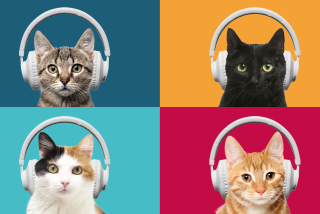The Accidental Chart Revolution : Pop music: Billboard’s new method of tracking sales is a byproduct of a once-rival market research system.
- Share via
Mike Shalett, a marketing research expert and a 20-year music industry veteran, has been fascinated by the weekly Billboard pop music sales charts for as long as he can remember.
As both a radio program director in the ‘70s and as a record company promotion man in the early ‘80s, Shalett pored through the charts for hot new records and for musical trends.
Little did he imagine all those years that he’d come up with a new system, one that would replace the methodology that had gone into determining what music America was listening to. Shalett’s system debuted in the May 25 issue of Billboard and immediately sparked a controversy in the record industry.
Some industry executives complained that the new system--which relied on high-tech sales measurement rather than store employee estimates--was based on an inadequate sample, one that favored established and mainstream acts over newcomers.
But the truth is that Shalett never intended to change the charts, per se. The overhaul in the Billboard rankings is the outgrowth of a research system that Shalett and partner Mike Fine designed in 1989 to sell to individual record companies. That system is now being offered by their New York-based company, SoundScan, to record companies at a price tag of about $800,000 per record manufacturer.
“The chart is not the primary advantage of SoundScan,” Shalett said. “The chart is a byproduct of the entire information management system. We designed the system so that it would provide information for the record business that is standard in almost every other industry.”
For years, record companies have estimated sales by counting the amount of records manufactured and shipped to retailers. The problem is that there is a difference between albums shipped and albums actually sold in the stores--and companies don’t have an exact count on what has been sold until the retailers return “unsold” albums, sometimes months later, for credit.
SoundScan’s alternative is to provide companies with precise information each week on what LPs, cassettes and CDs are actually sold--information gathered by a computerized system that is activated every time an album goes through a bar-code scanner at the sales counter.
“We realized that there had never been an accurate method in the music business to track actual sales,” Fine said. “Because of this, the record industry has never been able to employ the marketing strategies that, say, a Procter & Gamble or a Colgate could employ.”
Most industries--including the book, magazine, movie, television, grocery and retail clothing businesses--have used computerized accounting systems similar to SoundScan for years. According to Jeffrey Logsdon, senior vice president of Seidler Amdec Securities Inc., a Los Angeles brokerage firm, the music business has some catching up to do.
“The record industry is about three to five years behind everybody else,” Logsdon said. “The inventory situation in the music business has been a joke for years. A scanner chart system could have a dramatic impact.”
Who are these two relatively unknown market research analysts and how did they come to revolutionize the pop charts?
Shalett, 39, joined forces with Fine, 48, in 1987 to form Sound Data, a marketing service that tracks the buying habits of a panel of about 2,000 music consumers. All of the major record companies and MTV have subscribed to Sound Data since its inception. Other clients include Coca-Cola, Anheuser-Busch and R.J. Reynolds.
Fine also is the president of a 60-year-old New York research firm that has conducted presidential election exit polls for CBS-TV for more than two decades.
The two first began discussing the idea for a computerized sales data system with record manufacturers and retailers in the fall of 1989.
By the following August, SoundScan had signed deals with six of the country’s largest retail chains whereby the company would pay the chains to report their sales information exclusively to SoundScan. The six firms: Musicland, Camelot, Sound Warehouse, Show Industries, Record World and Trans World Music.
In October, 1990, Shalett and Fine presented a $7-million plan to the record labels, offering to provide the industry with an exclusive computerized information management system that could accurately track sales data. During this period, Billboard--which was providing companies with chart information for less than one-third of the cost--viewed SoundScan as a competitor to its own charts.
The record labels balked at SoundScan’s hefty price tag and SoundScan, looking for another foothold to demonstrate the value of its research to the industry, approached trade publications, offering its information as the basis for more accurate charts.
Shalett said last fall that he contacted Billboard--and other key trade publications, including Radio & Records, Hits and Album Network--to see if they wanted to buy the information. But he said they couldn’t agree on a price for the service.
By January, the six retail chains that had been signed up by SoundScan stopped reporting chart information to Billboard. These chains are believed to account for as much as 24% of the nation’s record sales.
During the same month, Shalett and Fine encouraged the record labels to sample their research findings, offering to provide the weekly service free. All of the major record companies took up the offer.
In March, SoundScan, still looking for a way to dramatize its value to the record industry, went back to Billboard, which was feeling the pressure of not having the six major retailers involved any longer in its chart makeup. SoundScan signed a deal to license chart information to Billboard for a fee, which neither company would disclose.
Earlier this month, SoundScan met with officials of the six major labels and reduced the price of the SoundScan service to less than $5 million. But none has signed up, most companies still calling the system too expensive.
“The system is flawed and the price is outrageous,” MCA Records President Richard Palmese said. “At this point in time, we are not going to sign on with SoundScan. Our company does not need Mike Shalett’s information to be successful. We have relationships with all the retail accounts and are getting our information through them.”
Negotiations with Bertelsmann Music Group, CEMA, PolyGram, Sony and WEA continue, but as of yet, no deals have been signed.
Jim Caparro, executive vice president of PolyGram Group Distribution, whose company represents 20 labels--including A&M;, Mercury, Polydor and Island--and accounts for $600 million in sales annually, questioned whether the SoundScan chart will survive.
“I think SoundScan’s idea was to go out and lock up the retailers, then negotiate a deal with Billboard and come back to the record companies hoping the industry would fund it,” Caparro said. “So far they’ve accomplished the first two steps. Whether or not they achieve the third step is still a big question mark.”
More to Read
The biggest entertainment stories
Get our big stories about Hollywood, film, television, music, arts, culture and more right in your inbox as soon as they publish.
You may occasionally receive promotional content from the Los Angeles Times.










